Chevrolet
Cruze Front Brake Pads Replacement Guide
How to change the front disc brake pads
on a 1st generation 2011 to 2015 GM Chevy Cruze with photos illustrated steps.
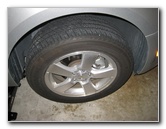 2013 Cruze Front Wheel |
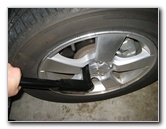 Slightly Loosen 5 Lug Nuts |
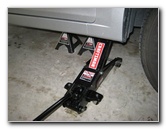 Raise Front of Car |
| This
automotive tutorial was specifically written to assist owners of the
first generation (2011, 2012, 2013, 2014 & 2015)
GM Chevrolet Cruze in changing the front disc brake pads. Owners of other similar General Motors sedan or hatchback vehicles such as the Chevy Sonic, Spark, Malibu, Impala, Holden Cruze, and Opel Astra may also find these front brake job instructions to be helpful. A few compatible replacement pads with their part numbers are as follows: Wagner ThermoQuiet QC1522, Bendix D1522 CQ, Raybestos PGD1522C or ATD1522C, Wagner QuickStop ZD1522, Monroe CX1522 and Power Stop 16-1522 Z16. The tools needed to complete this procedure include a lug nut wrench, a floor jack, two jack stands, a 10mm socket, a ratcheting wrench, a "C" or "F" clamp and a tube of brake parts lubricant grease. |
||
|
|
||
 Spin Off 5 Lug Nuts |
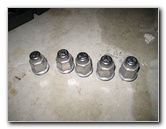 Lug Nuts Removed |
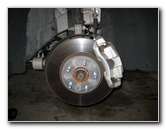 Caliper, Rotor, Bracket |
| The first few steps
are to park the vehicle on a level surface, engage the emergency / parking
brake and place wheel chocks on
both sides of the rear tires to prevent the car from moving. Then slightly loosen the five lug nuts on the front wheels with the tire iron. Raise the front of the car with the floor jack and securely support it with the two jack stands. I prefer to work on one side of the vehicle at a time for extra safety. Spin off the five lug nuts and set them aside in a safe place. Pull off the front wheel to reveal the front brake caliper, bracket, rotor and suspension. |
||
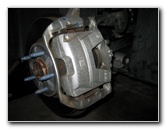 Front Brake Caliper |
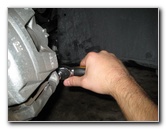 Loosen Lower 10mm Bolt |
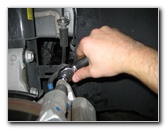 Loosen Upper Caliper Bolt |
| The brake caliper
is held in place to the bracket by two bolts on the back side of the
assembly facing in towards the engine. Loosen the upper and lower caliper bolts by turning them clockwise (as seen from the outside of the vehicle). |
||
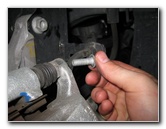 Remove Upper Bolt |
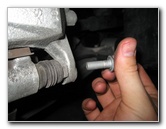 Remove Lower Caliper Bolt |
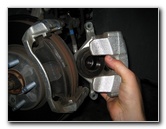 Pull Off Brake Caliper |
| Spin out the two
caliper bolts and set them aside in a safe place. Carefully pull the brake caliper out of the bracket and off the old pads. Rest the caliper on the top of the rotor or hang it from the spring with a bungee cord or some rope. Try to avoid stressing the rubber brake fluid line. |
||
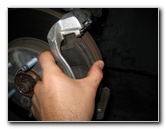 Remove Outer Brake Pad |
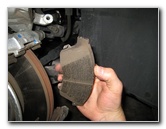 Remove Inner Brake Pad |
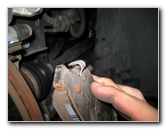 Wear Bar - Top Inner Pad |
| Pull out the old
outer and inner brake pads from the caliper bracket.
Make a mental note of where the wear indicator or "squeal" bar is located. On this 2013 Cruze, the wear bar was situated at the top of the inner brake pad. I recommend buying the Wagner ThermoQuiet QC1522 brake pads since they have great reviews on Amazon. I also like how they don't require any backing plates, shims or disc brake quiet gel due to the built in insulators. |
||
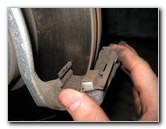 Replace Anti-Rattle Clips |
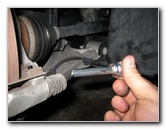 Pull Out Caliper Slider Pins |
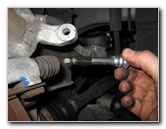 Lubricate & Replace Pins |
| If your new set of
brake pads included a hardware kit with replacement metal pad abutment or
"anti-rattle" clips, pull the old ones out of the top and bottom of the
caliper bracket before installing the new ones. In order for the caliper to work properly, the two caliper slider pins need to be well lubricated. Gently pull the caliper pins out of their rubber dust boots, apply a thin layer of brake caliper grease to each and then push them back in to place. |
||
|
|
||
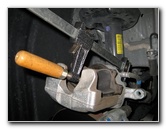 Attach "F" Clamp To Piston |
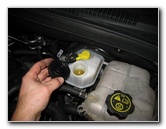 Twist Off Brake Fluid Cap |
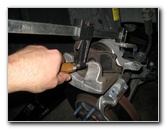 Compress Caliper Piston |
| In order for the
caliper to fit over the thicker new brake pads, you'll need to push back the
caliper piston by using a "C" or "F" clamp. Attach the "C" or "F" clamp to the piston using the back of an old brake pad to evenly distribute the pressure. Move to the right rear area of the engine bay, near the driver's seat, and twist off the brake fluid cap in the counter clockwise direction. Removing the brake fluid reservoir cap will allow the fluid to more easily travel backwards through the system when you compress the piston. Very slowly compress the caliper piston while repeatedly checking the level in the brake fluid reservoir to prevent it from overflowing. If any brake fluid does spill out, clean it up immediately since brake fluid can easily damage painted surfaces. Only compress the caliper piston until it is flush with its rubber dust boot. Try to avoid pinching the rubber dust boot or otherwise damaging it. Replace the brake fluid cap as soon as possible since brake fluid is hygroscopic and readily absorbs moisture from the air. Clean off the brake rotor, caliper bracket, brake caliper assembly and the lug nut studs with a brake parts cleaner spray. Do not use compressed air or blow with your mouth to clean off the parts since inhaling brake dust can be harmful to your health. Brake dust can be carcinogenic (causes cancer) if inhaled. Apply a thin layer of brake parts lubricant to any area where there is metal to metal contact such as the outer lip of the caliper piston. Do not apply caliper grease to the friction surface of the new pads.
To remove the existing rotors and install new ones, just remove the two bolts on the rear of the caliper bracket that attach it to the steering knuckle. Then loosen the old rotor with a rubber mallet, pull it off, and slide the new one in its place. |
||
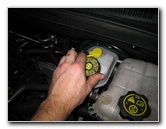 Replace Brake Fluid Cap |
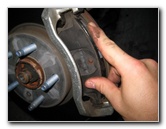 Install New Outer Pad |
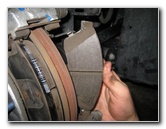 Wear Bar - Top Inner Pad |
| Insert the new brake pads in to the caliper bracket with the wear bar situated at the top of the inner pad. | ||
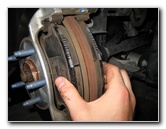 Push Pads Flush On Rotor |
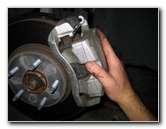 Replace Brake Caliper |
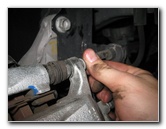 Re-Insert Upper Caliper Bolt |
| Push the two pads
together until they are flush against the rotor. Carefully lower the caliper down over the new pads and in to the bracket. Line up the bolt holes in the caliper with the corresponding holes in the caliper slider pins within the bracket. Spin in the two caliper bolts a few turns by hand to prevent them from becoming cross threaded. |
||
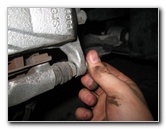 Spin In Lower 10mm Bolt |
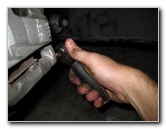 Tighten Lower Caliper Bolt |
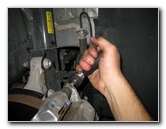 Tighten Upper Caliper Bolt |
| Tighten the upper
and lower caliper bolts by turning them counter clockwise (as seen from the
outside of the vehicle) with the 10mm socket and ratcheting wrench to just
past hand tight or about 21 ft lbs of torque. Verify that the caliper bolts are tight before moving on to the next steps. If your brake pedal has been feeling soft or "spongy", the brake fluid may be contaminated with water or the brake lines may contain air bubbles. It would be best to bleed the brake lines at this time in order to flush out the old fluid and replace it with fresh DOT 3 brake fluid. For more on this topic, check out my Brake Line Fluid Bleeding With An Assistant DIY Guide or alternatively the Brake Line Fluid Bleeding With A Power Bleeder Guide. The brake fluid bleeder valve is located underneath a rubber cap on the back side of the caliper just below the upper caliper bolt. |
||
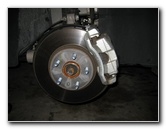 Double Check Both Bolts |
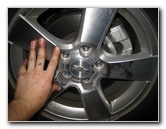 Replace Front Wheel |
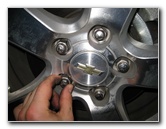 Spin On 5 Lug Nuts |
| Replace the front wheel and spin on the five lug nuts by hand to prevent them from becoming cross threaded. | ||
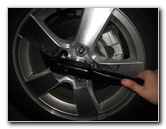 Slightly Tighten Lug Nuts |
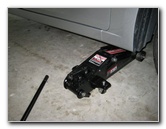 Lower Vehicle From Stands |
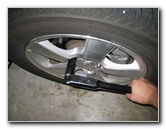 Torque Lug Nuts |
| Slightly tighten
the lug nuts in a criss cross or star pattern with the tire iron. Lower the vehicle from the jack stands using the floor jack. Continue progressively tightening the lug nuts in a star pattern to about 1/4 turn past hand tight or 100 ft lbs of torque. It would be best to use a torque wrench or impact wrench with a torque stick to properly tighten the lug nuts. Sit in the driver's seat of your Cruze and pump the brake pedal a few times to restore brake line pressure. Verify that the brake fluid level in the reservoir is correct. Add some new DOT 3 brake fluid if it is low. Take the car for a short and cautious test drive with the windows down so you can hear any abnormal noises while braking. To break in your new pads, just drive normally for the first several hundred miles while trying to avoid any hard or "panic" stops which may glaze over the new pads and cause them to be noisy and/or not perform as well. It's also a good idea to check your driveway for drops of brake fluid which may indicate a leak, check the brake fluid level in the reservoir, and also verify that the lug nuts are still tight. For more,
check out my other
Chevrolet Cruze Repair & Maintenance Guides. |
||
| If you found this guide to be helpful,
please consider making a small donation by clicking on the PayPal.com
"Donate" button located to the right of this paragraph. Thank you!
(Note: I am not a registered charity. Donations are not tax deductible.) |

